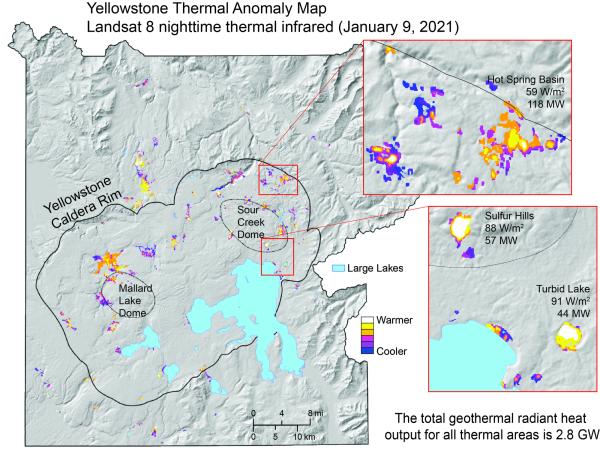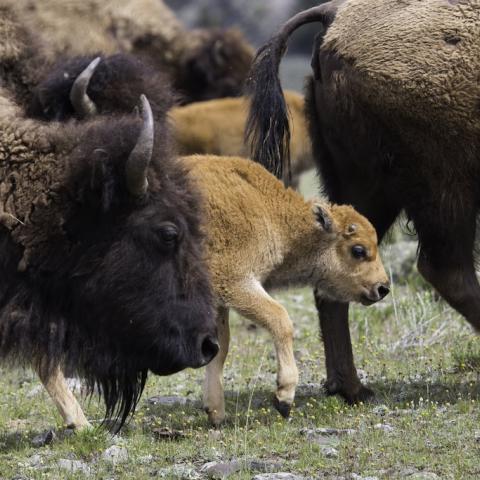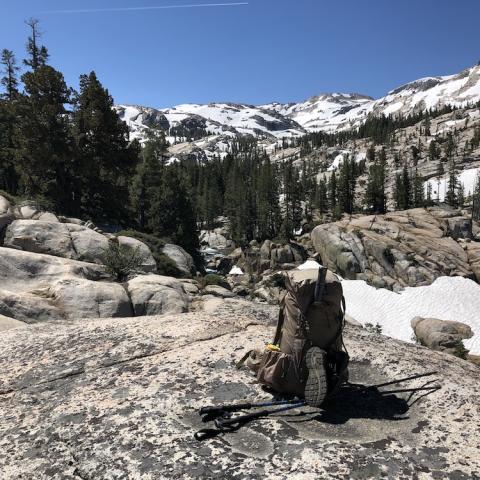Editor's note: Yellowstone Caldera Chronicles is a weekly column written by scientists and collaborators of the Yellowstone Volcano Observatory. This week's contribution is from Jess Condon, U.S. Geological Survey Volunteer and Northern Arizona University student, and R. Greg Vaughan, research geologist with the U.S. Geological Survey.
In past editions of Yellowstone Caldera Chronicles, we’ve discussed how to get free thermal infrared images of Yellowstone. Other topics have included how to interpret these images, and how to process the data into temperature images. Now it’s time to take the final step: calculating important thermal metrics that we can use for monitoring change over time.
First, some definitions. The difference between temperature and heat is subtle, but important. A material can have a temperature, but it cannot have heat – it can only gain or lose heat. Think of temperature as a material property and heat as a measure of change. Temperature is a measure of the average kinetic energy of the molecules that make up a substance. It is measured in Kelvin (K), or degrees Celsius (°C), or degrees Fahrenheit (°F). Heat is a flow of energy; it is measured in Joules (J) or calories (cal). Radiant heat (also called, thermal radiation or radiant energy) is a flow of energy via electromagnetic radiation.
There are two final terms to understand. Radiant power (also called radiant flux) is the flow of radiant heat over time and is measured in Joules per second, which is the same thing as Watts (W). Radiant emittance (also called radiant exitance) is the radiant power emitted per unit area; it is measured in Watts per square meter (W/m2). Imagine a cup of hot cocoa, coffee, or tea at the deliciously drinkable temperature of 160 °F (71 °C). Its surface would be emitting thermal infrared radiation with a radiant emittance value of about 783 watts per square meter. Assuming a typical sized mug, it would have a radiant power output of about 4.7 watts. Scale that up significantly to compare to Yellowstone.
The reason these are important metrics is because volcanoes often show anomalous thermal activity before eruptions. Should there ever be elevated volcanic unrest in Yellowstone, it could appear as increased thermal activity at the surface (in addition to anomalous seismicity, ground deformation, gas emissions, etc.). But such thermal activity may not show up as increased temperatures; it may show up as an increased area of a static high temperature. This is why temperature measurements alone are not enough. We also need to calculate how much heat is radiated away over time from different areas—that is, radiant emittance and radiant power output.
Using satellite-based thermal infrared temperature images, we can use a principle of physics called the Stefan-Boltzmann law to calculate radiant emittance, in Watts per square meter, then multiply by the pixel area to calculate radiant power output, in Watts. Easy-peasy.

Thermal anomaly map of Yellowstone National Park, based on a Landsat 8 nighttime thermal infrared image from 9 January 2021. The color ramp indicates the intensity of the above-background thermal anomaly for each thermal area. Lakes are blue. Yellowstone caldera and resurgent domes are outlined in black. Thermal areas in the inset images are annotated with geothermal radiant emittance values in Watts per square meter (W/m2), and geothermal radiant power output values in megawatts (MW; 1 megawatt is 1 million watts).
However, the situation in Yellowstone has a complication. Every place in Yellowstone—thermal areas and non-thermal areas alike—receives sunlight during the day, which warms the surface. The radiant surface heat that is measured by satellite thermal infrared sensors is a combination of heat derived from absorbed sunlight and heat the comes from below (geothermal heat). This is one of the reasons we focus our analyses on images acquired at night. This minimizes, though does not completely eliminate, the effects of the Sun. And it turns out that the heat from absorbed sunlight at the surface far exceeds the geothermal heat at the surface, even in some of the thermal areas. The challenge, then, is to isolate just the geothermal component of the heat.
To do this, for every thermal area in Yellowstone we have defined a nearby non-thermal background area that has a similar surface cover type and topography, both of which affect how much sunlight is absorbed. The radiant emittance of the background, calculated from the thermal infrared remote sensing data, is subtracted from the radiant emittance of the thermal area. This results in geothermal radiant emittance values, and when we multiply by the pixel area, we get geothermal radiant power output values. And we can make thermal anomaly maps that show the distribution of the thermal areas and their relative geothermal radiant power output.

Plot showing the total geothermal radiant power output from Yellowstone’s thermal areas based on Landsat 8 and Landsat 9 thermal infrared images from 2014 to 2024. Only data from clear, nighttime, wintertime (November through March) dates were used. The results indicate that there has been no significant change over the last 10 years.
If we sum the geothermal radiant power output values for each thermal area, we get a total value for all the thermal areas together. From the data acquired on 9 January 2021, the total park-wide value is about 2800 million watts or 2.8 gigawatts (GW)—more than enough to send a DeLorean “back to the future.”
The next question is, how has this value changed with time? We have calculated total geothermal radiant power output values for multiple Landsat 8 and 9 thermal infrared images going back to 2014. To obtain as accurate and consistent a result as possible, we only used data from clear nighttime images acquired in the winter months (November through March).
So, is Yellowstone heating up, or cooling down? The answer appears to be neither. Although individual thermal areas can be very dynamic in their appearance and in their thermal output, on a park-wide scale the total heat out output from the thermal areas appears to be stable over the years, hovering around 2.5 GW.
Thermal infrared satellite images are an important method for monitoring volcanoes and geothermal areas because of their ability to quantify subtle thermal characteristics of the landscape. YVO scientists will continue to use these data to track the heat output of Yellowstone’s thermal areas, establishing a baseline for what is normal so that we can recognize any anomalies should they ever appear in the future.




 Support Essential Coverage of Essential Places
Support Essential Coverage of Essential Places







Add comment